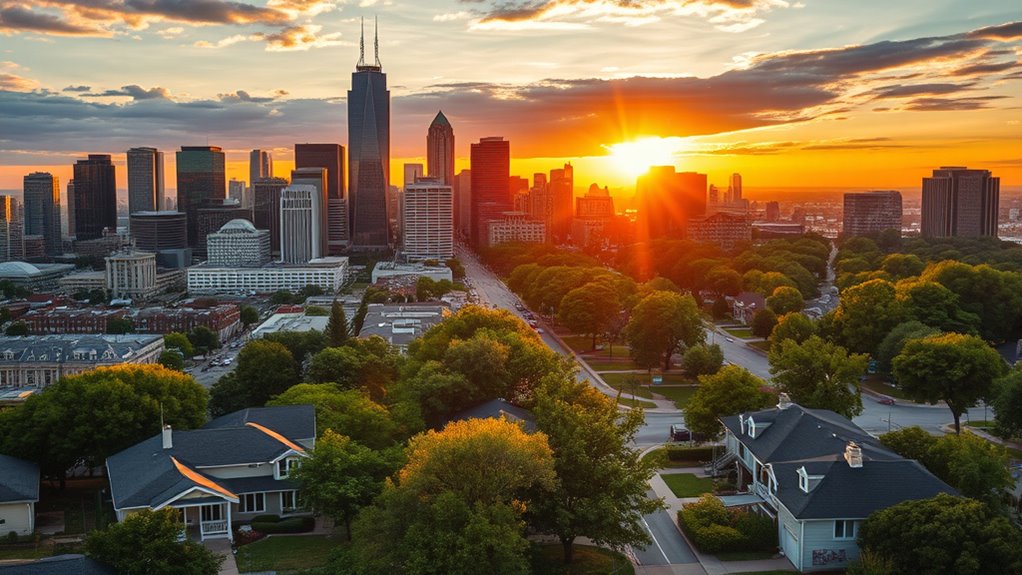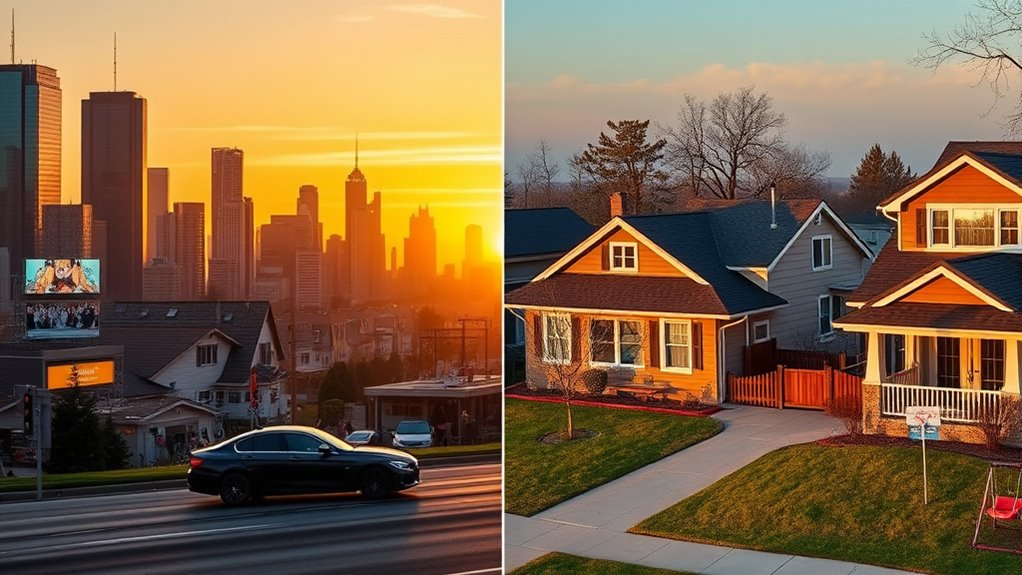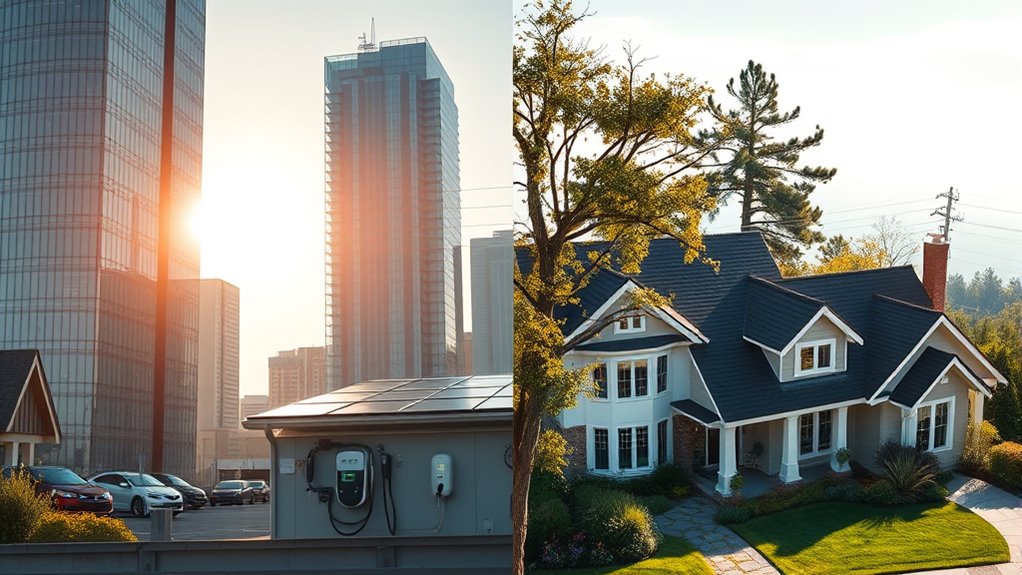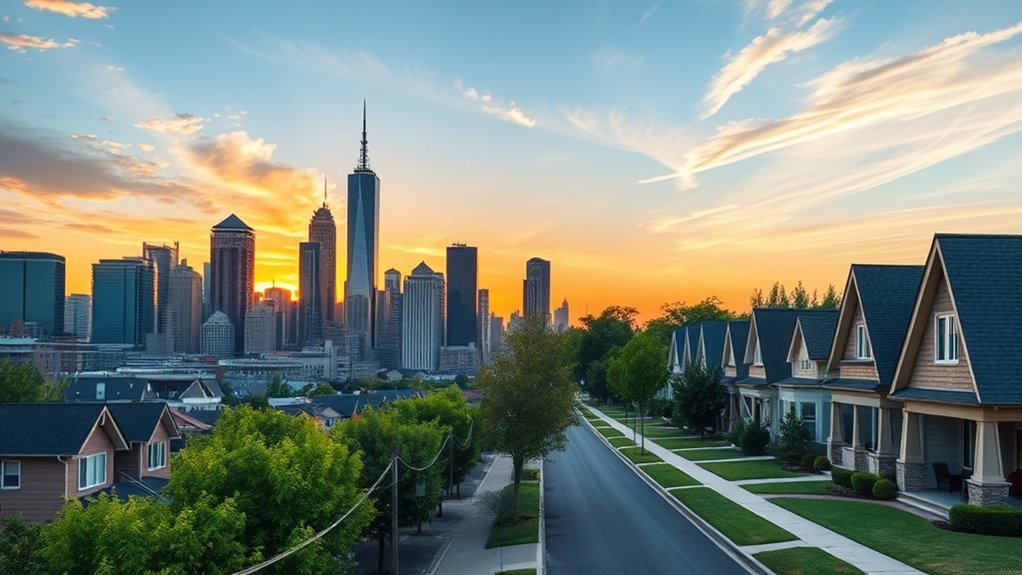In 2025, city living tends to cost more in housing, with higher median home prices and rent, as well as increased transportation and utilities expenses due to limited space and reliance on public transit. Suburbs offer more affordable housing, larger properties, and lower property taxes but may mean longer commutes and higher fuel costs. Rural areas have the lowest housing costs but can face higher utility and transportation expenses. For a deeper look at how these differences impact your lifestyle, keep exploring.
Key Takeaways
- Urban areas have higher housing costs and property taxes, with median home prices around $190,900 in 2025.
- Suburban regions offer more affordable housing and larger properties but face rising prices and market volatility.
- Urban residents pay more for public transit and parking, while suburban residents spend more on longer commutes and vehicle expenses.
- Rural areas have lower housing costs but higher utility, energy, and transportation expenses due to infrastructure limitations.
- Healthcare access and costs vary, with urban areas offering more providers at higher prices, while rural areas face limited options and increased travel costs.
Housing Price Disparities Between Urban and Suburban Areas

Housing prices vary considerably between urban and suburban areas, with urban homes generally being more expensive. You’ll find higher median home values in cities due to increased demand, limited space, and better amenities. Homeownership incentives, like tax credits or grants, can help offset some costs in urban markets, but property tax rates are typically higher, adding to your overall expenses. Suburban areas often offer more affordable housing options, with lower property tax rates and larger properties, making them attractive for buyers seeking value. As suburban housing prices rise rapidly—up 36% between 2020 and 2023—they become increasingly competitive. Understanding these disparities helps you evaluate where to invest or settle, balancing affordability with access to urban amenities and incentives. Additionally, market volatility can influence housing prices and investment decisions in both urban and suburban markets.
Monthly Mortgage and Rent Cost Variations

Monthly mortgage and rent costs vary considerably between urban, suburban, and rural areas, affecting your overall affordability. In urban markets, higher housing prices and mortgage rates push monthly payments upward, while suburbs often offer more affordable options with lower mortgage rates. Rural areas typically have the lowest housing costs but may involve higher utility or transportation expenses. Additionally, home theater projectors are increasingly popular in various living environments, influencing how residents enjoy entertainment at home. Here’s a comparison:
| Area | Median Home Price | Typical Monthly Mortgage | Median Rent |
|---|---|---|---|
| Urban | $190,900 | $1,561 | Higher |
| Suburban | Slightly lower | Lower than urban | Moderate |
| Rural | About $151,300 | $1,271 | Usually less |
Understanding these differences helps you navigate the housing market and plan your budget effectively for 2025.
Transportation Expenses in City Versus Suburb Settings

Transportation expenses vary markedly between city and suburban residents, primarily due to differences in commuting patterns and transportation options. In cities, you often pay higher public transit fees and parking fees, but you might save on fuel and vehicle maintenance. Suburbs typically require longer drives, increasing fuel and car repair costs, though parking fees are usually lower or nonexistent. Urban areas provide more public transit options, which can reduce your reliance on personal vehicles. Conversely, suburban sprawl leads to longer commutes, raising annual transportation expenses. Consider these factors:
- Public transit costs and availability
- Parking fees in urban centers
- Fuel and maintenance for longer drives
- Commuting distance and time
- Reliable backup power options can help mitigate disruptions caused by transit strikes or power outages affecting transportation infrastructure.
Your transportation costs depend on your location, lifestyle, and commuting habits, shaping your overall expenses.
Utility and Energy Cost Differences

When it comes to utility and energy costs, your location plays a substantial role in how much you’ll spend. Rural households often spend more, with a median energy burden of 4.4%, due to less efficient infrastructure and reliance on propane, heating oil, or septic systems. Urban areas benefit from centralized utility services that support energy efficiency programs, reducing costs. Suburban homes may have varying expenses depending on their age and insulation quality—older houses tend to be less efficient. Installing solar panels can lower energy bills considerably, especially in sunny regions. Additionally, participating in energy efficiency programs helps cut costs and reduce environmental impact. Furthermore, understanding types of headphone jacks can be useful when selecting compatible devices for energy-efficient setups. Overall, your energy expenses hinge on regional infrastructure, housing type, and your willingness to adopt renewable solutions.
Grocery and Food Spending Patterns

You may notice that urban residents often spend more on groceries and dining out than those in suburbs or rural areas. Supermarkets in cities tend to have higher prices, and eating out can quickly add up. These spending patterns influence your food budget and can vary markedly depending on where you live. Additionally, exploring grocery savings strategies can help mitigate these costs and make your food budget more manageable.
Urban Grocery Price Trends
Urban grocery prices tend to be higher than in suburban and rural areas, driven by factors like elevated rent for retail space, increased labor costs, and greater demand for convenience foods. In many urban neighborhoods, food deserts limit access to affordable fresh produce, pushing residents toward expensive convenience stores. To combat this, many city dwellers rely on grocery delivery services, which can add to costs but save time. You may also notice higher prices at urban supermarkets due to higher operational expenses. Additionally, limited local options sometimes lead to reliance on distant stores, raising transportation costs. Despite these challenges, urban residents often pay a premium for quick, accessible food options, which influences overall grocery spending patterns compared to suburban and rural areas. Furthermore, cost management strategies like bulk purchasing and shopping during sales can help urban dwellers reduce grocery expenses.
Food Budget Variations
Food spending patterns vary markedly between city, suburb, and rural residents, largely influenced by grocery prices, eating habits, and access to food sources. In cities, higher grocery costs and greater reliance on convenience stores often lead to increased food budgets. Suburban residents benefit from local food sourcing options like farmers’ markets, which can offer fresh produce at lower prices or better quality. Rural areas may face limited grocery store options, sometimes resulting in higher prices or reliance on distant stores, increasing overall food expenses. Additionally, suburban and rural households often source food locally, reducing transportation costs and supporting regional farmers. These differences in food budget allocations impact overall living costs and influence choices around meal planning, grocery shopping, and food sourcing strategies.
Dining Out Costs
Dining out expenses vary markedly across city, suburb, and rural areas, shaped by local prices, availability, and lifestyle preferences. In cities with vibrant urban nightlife, you’ll likely spend more on restaurant meals and recreational activities, fueling social outings. Suburban areas often offer more budget-friendly dining options, with larger chain restaurants and casual spots. Rural regions may limit options, leading to higher costs if you travel farther for quality meals. Additionally, wall organization systems can influence the overall ambiance and accessibility of dining spaces, potentially impacting dining experiences and related expenses.
Healthcare Access and Cost Implications

Healthcare access and costs vary considerably depending on where you live, impacting your overall well-being and finances. Healthcare disparities often mean urban areas have more providers, specialists, and facilities, making medical access easier but sometimes more expensive. Suburban healthcare options can be plentiful but may require travel, adding to costs and inconvenience. Rural areas face significant challenges: fewer providers, longer travel times, and limited specialty care, which can lead to delayed treatment or higher emergency expenses. Insurance premiums and out-of-pocket costs tend to be higher in urban settings, driven by higher service prices. Conversely, rural residents may face lower premiums but increased costs due to travel and limited local options. These differences influence your ability to access quality healthcare affordably, shaping your overall health and financial stability. Additionally, understanding city dynamics can help residents better navigate healthcare systems and optimize their access.
Overall Cost of Living and Lifestyle Trade-offs

When weighing the overall cost of living in city, suburban, or rural areas, you’ll find that each setting offers distinct lifestyle trade-offs. Urban areas often mean higher expenses for housing, food, and transportation but provide more amenities and job opportunities. Suburbs balance costs with greater space and community engagement, though some may face rising housing prices. Rural areas typically offer lower housing costs but can incur higher utilities, transportation, and food expenses. Your lifestyle flexibility depends on your priorities—urban living favors convenience, while suburbs and rural areas provide more space and community ties. Consider these trade-offs:
- Urban: higher costs, diverse community engagement
- Suburban: moderate costs, family-friendly environment
- Rural: lower housing costs, limited amenities
- All: lifestyle flexibility varies by location and personal preference
- Additionally, road signs play an important role in ensuring safety and efficient traffic flow across all these areas.
Impact of Remote Work on Location Choices

Remote work has profoundly reshaped how people choose where to live, giving you greater flexibility to prioritize affordability, quality of life, or proximity to urban centers. With the ability to work from anywhere, you can opt for locations with better urban infrastructure or richer cultural amenities without sacrificing your job. This shift enables you to move to suburban or rural areas with lower housing costs, while still accessing essential services and entertainment options. Many now value the balance between cost savings and quality of life, making location decisions more strategic. As a result, some are leaving expensive cities for more affordable suburbs, where improved infrastructure and cultural amenities improve daily living. Additionally, the availability of low light office plants can enhance home office environments, making remote work spaces more pleasant and productive. Remote work reshapes the traditional city vs. suburb dynamic, expanding your options based on personal priorities.
Frequently Asked Questions
How Do Property Tax Differences Affect Total Housing Costs in Cities Versus Suburbs?
Property tax disparities substantially impact your total housing costs in cities versus suburbs. Urban areas often have higher property taxes, which can reduce housing affordability despite lower home prices. In contrast, many suburbs offer lower property taxes, making homes more affordable overall. These differences influence your monthly expenses and long-term costs, so consider property tax rates carefully when comparing city and suburban housing options to find the best balance for your budget.
What Are the Long-Term Financial Impacts of Choosing Urban Versus Rural Living?
Choosing urban living may lead to higher commuting costs but offers better property appreciation potential, boosting your investment over time. Rural living often means lower housing costs initially but can incur higher transportation expenses due to longer commutes. Consider how property appreciation and ongoing commuting costs impact your long-term finances. Your decision hinges on balancing immediate savings against future investment growth and the ongoing expenses tied to your lifestyle.
How Does Crime Rate Influence Insurance Premiums and Overall Expenses?
Ironically, a higher crime rate can make your insurance premiums skyrocket, even if you think you’re safe with neighborhood safety measures. When crime goes up, insurers see increased risk, raising costs for homes and vehicles. Emergency preparedness becomes essential, but it doesn’t always lower premiums. You end up paying more for coverage and expenses, realizing that safety efforts alone can’t fully shield you from the financial impact of living in a high-crime area.
In What Ways Do School Quality and Access Vary Between Urban and Suburban Areas?
You’ll find school quality and access differ greatly between urban and suburban areas. Urban schools often face funding disparities, leading to fewer resources and extracurricular opportunities. Suburban schools usually benefit from better funding, offering more extracurricular access and advanced programs. As a result, you might notice higher academic standards and more activities in suburban districts, making them more attractive for families prioritizing education and diverse extracurricular options.
How Do Future Infrastructure Developments Impact Cost-Of-Living Projections?
Future infrastructure developments can lower your cost of living by improving public transit and creating green spaces. Enhanced transit options reduce your reliance on personal vehicles, saving you money on fuel and parking. Green spaces increase quality of life and can even lower energy costs by providing natural cooling. These improvements attract more residents, which might raise property values but also make living in the area more sustainable and affordable over time.
Conclusion
As you weigh city versus suburb living in 2025, remember that the average housing cost in cities is 30% higher, but transportation can be more affordable with public transit. notably, nearly 60% of remote workers now prefer suburbs for more space and lower costs. Ultimately, your choice balances financial savings against lifestyle preferences—knowing these differences helps you make a confident decision for your future.










